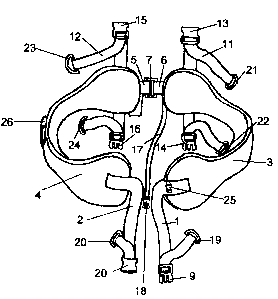Une partie des informations de ce site Web a été fournie par des sources externes. Le gouvernement du Canada n'assume aucune responsabilité concernant la précision, l'actualité ou la fiabilité des informations fournies par les sources externes. Les utilisateurs qui désirent employer cette information devraient consulter directement la source des informations. Le contenu fourni par les sources externes n'est pas assujetti aux exigences sur les langues officielles, la protection des renseignements personnels et l'accessibilité.
L'apparition de différences dans le texte et l'image des Revendications et de l'Abrégé dépend du moment auquel le document est publié. Les textes des Revendications et de l'Abrégé sont affichés :
| (12) Demande de brevet: | (11) CA 2646243 |
|---|---|
| (54) Titre français: | THE SLING-BELT (BANDOULIERE) |
| (54) Titre anglais: | THE SLING-BELT |
| Statut: | Réputée abandonnée et au-delà du délai pour le rétablissement - en attente de la réponse à l’avis de communication rejetée |
| (51) Classification internationale des brevets (CIB): |
|
|---|---|
| (72) Inventeurs : |
|
| (73) Titulaires : |
|
| (71) Demandeurs : |
|
| (74) Agent: | |
| (74) Co-agent: | |
| (45) Délivré: | |
| (22) Date de dépôt: | 2008-12-02 |
| (41) Mise à la disponibilité du public: | 2010-06-02 |
| Licence disponible: | S.O. |
| Cédé au domaine public: | S.O. |
| (25) Langue des documents déposés: | Anglais |
| Traité de coopération en matière de brevets (PCT): | Non |
|---|
| (30) Données de priorité de la demande: | S.O. |
|---|
The Sling-Belt is a device enabling an individual to transport a snowboard or
a pair of skis, worn
diagonally across their back. This design allows for unimpeded use of the arms
and thus facilitates
navigation under relevant conditions. The device consists of a primary strap
comprised of
ergonomically shaped padding in addition to webbing, the latter having
buckling elements attached
thereto, and, when buckled and adjusted, this strap forms a loop that is worn
diagonally across the
torso. Additionally, the primary strap has a plurality of secondary straps
attached transversely thereto.
These are drawn around the snowboard or skis, fastened, again using buckles,
and tightened, such that
the equipment is firmly attached. There is a further, adjustable, tertiary
strap, connected transversely to
the main strap, again using a buckle, that improves stability and comfort. The
device is worn around the
waist, as like a belt, when not in use.
Note : Les revendications sont présentées dans la langue officielle dans laquelle elles ont été soumises.
Note : Les descriptions sont présentées dans la langue officielle dans laquelle elles ont été soumises.

2024-08-01 : Dans le cadre de la transition vers les Brevets de nouvelle génération (BNG), la base de données sur les brevets canadiens (BDBC) contient désormais un Historique d'événement plus détaillé, qui reproduit le Journal des événements de notre nouvelle solution interne.
Veuillez noter que les événements débutant par « Inactive : » se réfèrent à des événements qui ne sont plus utilisés dans notre nouvelle solution interne.
Pour une meilleure compréhension de l'état de la demande ou brevet qui figure sur cette page, la rubrique Mise en garde , et les descriptions de Brevet , Historique d'événement , Taxes périodiques et Historique des paiements devraient être consultées.
| Description | Date |
|---|---|
| Inactive : Demande ad hoc documentée | 2012-01-24 |
| Demande non rétablie avant l'échéance | 2011-12-02 |
| Le délai pour l'annulation est expiré | 2011-12-02 |
| Inactive : Demande ad hoc documentée | 2011-09-06 |
| Réputée abandonnée - omission de répondre à un avis sur les taxes pour le maintien en état | 2010-12-02 |
| Demande publiée (accessible au public) | 2010-06-02 |
| Inactive : Page couverture publiée | 2010-06-01 |
| Exigences pour le changement d'adresse - jugé conforme | 2009-07-23 |
| Requête pour le changement d'adresse ou de mode de correspondance reçue | 2009-07-06 |
| Inactive : Lettre officielle | 2009-01-16 |
| Inactive : CIB en 1re position | 2009-01-16 |
| Inactive : CIB attribuée | 2009-01-16 |
| Inactive : CIB attribuée | 2009-01-16 |
| Inactive : CIB attribuée | 2009-01-16 |
| Demande reçue - nationale ordinaire | 2009-01-13 |
| Exigences de dépôt - jugé conforme | 2009-01-13 |
| Inactive : Certificat de dépôt - Sans RE (Anglais) | 2009-01-13 |
| Déclaration du statut de petite entité jugée conforme | 2008-12-02 |
| Date d'abandonnement | Raison | Date de rétablissement |
|---|---|---|
| 2010-12-02 |
| Type de taxes | Anniversaire | Échéance | Date payée |
|---|---|---|---|
| Taxe pour le dépôt - petite | 2008-12-02 |
Les titulaires actuels et antérieures au dossier sont affichés en ordre alphabétique.
| Titulaires actuels au dossier |
|---|
| ANDREW JASON SIMS |
| Titulaires antérieures au dossier |
|---|
| S.O. |